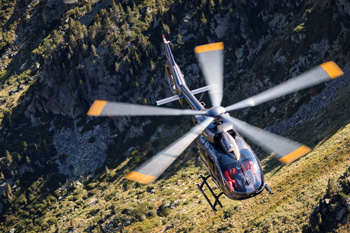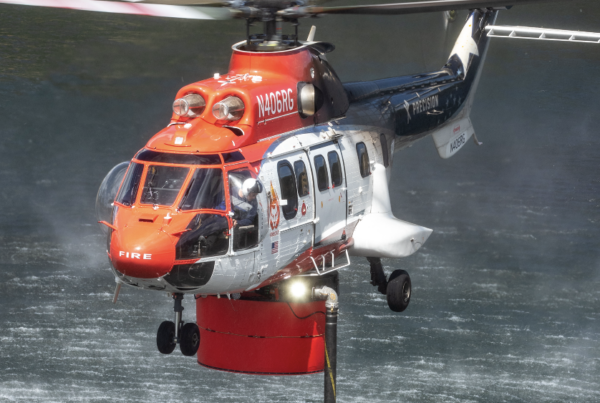The use of night vision goggle technology has ushered in a quiet revolution in aerial firefighting in Australia and the US, with conditions during the hours of darkness often found to be better than those during daylight hours. Emma Kelly reports.
Advancements in Night Aerial Firefighting (NAFF) Capabilities in Australia
A number of Australian States were dealing with flood emergencies rather than bushfires during the early part of the 2022-23 fire season, but the country’s fire authorities and aerial firefighting fleet are ready for fire activity and expanding their capabilities as the country dries out.
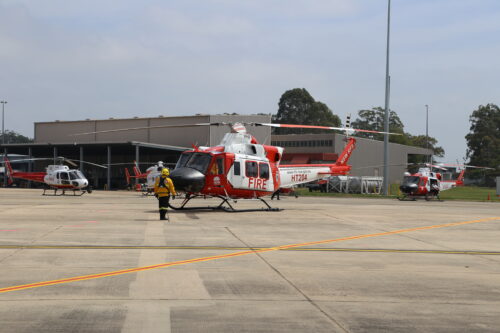
Coulson Aviation developed its NAFF capabilities following 2009’s devastating bushfires
Introduction of Night Aerial Firefighting (NAFF)
Night aerial firefighting (NAFF) has been added to the arsenal of weapons that authorities in parts of Australia can deploy. The capability has been developed over a number of years in Victoria, with New South Wales more recently conducting its own trials, while other states and territories watch with interest.
NAFF developments accelerated following the devastating Australian Black Saturday bushfires in Victoria in February 2009, which caused widespread devastation, the loss of 173 lives, the death of more than one million animals and 450,000 hectares of land burned.
Coulson Aviation’s Role in NAFF Development
The Black Saturday fires prompted aerial firefighting specialist Coulson Aviation to develop the capability of conducting aerial operations at night using night vision goggles (NVG). Night operations allow firefighters to capitalise on more favourable weather, with temperatures and wind speed generally dropping and humidity often rising, resulting in water and retardant drops being more effective than during the day.
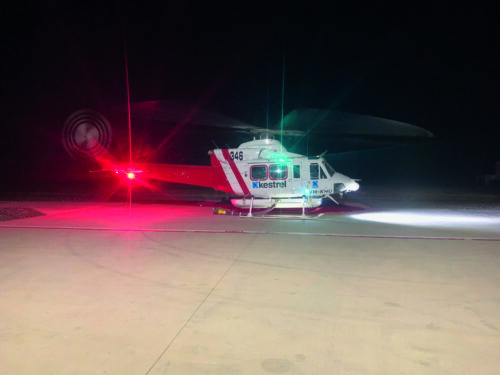
Early days: together with Coulson and its Type 1 Sikorsky S-61, Kestrel Aviation helped pioneer night aerial firefighting capability using its Type 2 Bell 412. (Kestrel Aviation)
Coulson developed the capability using an NVIS-equipped Sikorsky S-61 firefighting helicopter and a Sikorsky S-76 supervision aircraft. Using NVG and laser technology, Coulson demonstrated the ability to pinpoint the ideal drop zone for the firefighting helicopter, enabling greater accuracy than during daytime operations, while thermal imaging technology allows a fire’s movement to be monitored. Over numerous trials, Coulson successfully developed the capability of hover filling over open water sources and selecting the most effective drop zone.
Coulson is building year-round NAFF experience, with operations in Australia and the United States. In the US, it has been operating at night for the past five years, with a trial followed by full operations for the last four years. Coulson is now able to conduct initial attack fire operations under NVGs, says Britt Coulson, CEO of Coulson Aviation Australia and President of Aviation at Coulson Group.
Quick Reaction Force (QRF) Programme and Night Vision Technology
Under the Quick Reaction Force (QRF) programme, which is funded and undertaken in partnership with Southern California Edison, Orange County, Los Angeles County and Ventura County, Coulson is delivering a 24/7 operational capability, using Boeing CH-47 Chinook very large helitankers, S-61 helitankers and an S-76 intelligence gathering platform. The helicopters are outfitted for night vision operations, with crews using NVG and undertaking in-depth training. The aircraft also features traffic collision avoidance systems and terrain avoidance warning systems, with Coulson currently adding thermal cameras and HUD systems to the platforms.
“The teams have responded to hundreds of fires and completed thousands of drops – with over 60% at night,” says Coulson, adding that it has been extremely effective. “The teams have yet to fight the same fire two days in a row, with the exception of large campaign fires for high-value asset protection.”
Australia’s NAFF experience and capabilities have developed slowly but surely over the past decade to demonstrate capabilities and benefits. In recent years, successive La Niña events featuring higher-than-average rainfall in large parts of the country have also slowed the development of operational capability.
The Partnership Between Coulson Aviation and Kestrel Aviation
Coulson and Australian-owned specialist helicopter operator Kestrel Aviation pioneered Australian capability in Victoria with Emergency Management Victoria (EMV) using Coulson’s Type 1 S-61 and Kestrel’s Type 2 Bell 412 in the Night Fire Aviation Programme (NFAP).
The first NVG operating approval was issued for the 2015-16 season, and implementation started as a trial in the 2017-18 season, including developing the ability to hover fill from remote water sources at night. Operations continued during 2018-19, with active engagements in the remote, mountainous terrain of eastern Victoria and the urban interface east of Melbourne, says Coulson. “During the 2019-20 fire season, following on from the success of the previous season, Coulson undertook the first NVG initial attack fire operation in Victoria in the western region of the State,” he adds.
Key Regulatory Milestones in Night Vision Firebombing Operations
Testing and capability developments have resulted in a number of key regulatory milestones over the last couple of fire seasons. In late 2021, Kestrel received Australian-first regulatory approval from the Civil Aviation Safety Authority to conduct unrestricted night vision firebombing operations for the preservation of life and critical infrastructure, allowing Kestrel’s NVG-enabled aircraft to react to fires in a first-strike capability, comparable to its daytime operations, and without the requirement for day reconnaissance flights or a supervisory aircraft to coordinate water collection or drops. Kestrel is the only operator in Australia with such regulatory approval for unrestricted first attack, says Richard Butterworth, Kestrel Aviation’s Head of Training and Night Aerial Firefighting Programme Manager and Lead Pilot. “Kestrel’s regulatory approval is the most advanced in the southern hemisphere, striking the optimum balance between operational scope and the maintenance of both flight and ground safety,” he says. Kestrel has conducted more than 500 fill-and-drop sequences over multiple seasons and fire grounds.
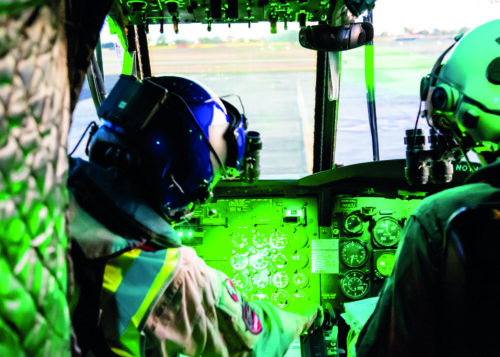
Green screen: night operations allow firefighters to make the most of more favourable conditions, such as lower temperatures and increased humidity. (Aviation Spotters Online)
Coulson Aviation’s NVG Operations Approval
In 2022, Coulson gained CASA approval to conduct NVG operations in Australia using the CH-47D, which already had several successful years of operations in the US. “This approval also means Coulson can hover fill from open water sources at night during operations without a daytime flight over the area of intended operations,” adds Coulson.
Continuing NVG Operations in Victoria
NVG operations are continuing in Victoria this fire season, says EMV. “The NFAP is now in its seventh year and will continue in 2023 in line with Victoria’s highest risk period for fires,” says EMV. “Victoria continues to integrate night operations into our current suite of aircraft services to help manage fires and other emergencies, including air intelligence gathering, which will be critical in detecting fires at night,” it says. EMV says a number of enhancements have been made to the technology onboard its air attack platforms, including infra-red high-definition video cameras to support airborne information gathering both day and night to assist operational decision-making, with content able to be streamed to incident, regional or State control centres. EMV says going forward, “Victorian agencies will work with other jurisdictions and the aviation sector to trial, share and embed learnings to continually enhance the State’s approach to night fire aviation.”
In mid-January, Victoria was expecting normal fire potential for the north and west of the State, with the main risk being increased grass fires as the grass dries out following considerable growth following high rainfall.
Long-term Commitment for NVG Programmes
At the time of writing, Coulson was in discussions with Victoria on future NAFF. “Due to the highly specialised nature of the training and pilots to undertake effective and safe NVG operations, programmes need long-term commitment from States to be viable, even where some seasons have a predicted lower fire risk,” Coulson explains.
“Coulson Aviation’s first NVG fire operations were in Australia after three years of training and trials at a cost to the organisation,” says Coulson. “When Coulson started, no other organisation was commercially doing this type of operation with large helicopters,” he says, adding it remains the only organisation using Type 1 helicopters for NAFF.
Leveraging International Experience and Cross-Country Learning
Australia and the US have benefited from the experience gained over the years in each country. Coulson says it was able to take the NFAP experience in Australia and “confirm and solidify the innovation” with the CH-47 and S-61 in California.
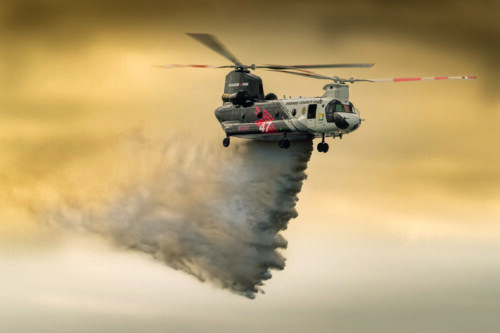
Heavy duty: Coulson’s Boeing CH-47 Chinook is an integral part of the Quick Reaction Force
While Australian and US fire environments are different in terms of vegetation and weather, NVG procedures remain relatively constant between the two countries, says Coulson. The operator uses the same pilots, and learnings are applied to each jurisdiction. “The international nature of our company affords us the opportunity to leverage our experience in Australia and the USA and vice versa. Every year we gain more experience and refine our training and manuals to take advantage of those lessons learned,” says Coulson.
Objectives of Kestrel’s NAFF Development
For Kestrel, NAFF development had two main objectives, according to Butterworth. “The first was to meet the operational capability requirements for the specific firefighting agency, in this case being EMV,” he says. Prior to Victoria’s NFAP, Butterworth says NAFF had been solely conducted in the US under a different operational context.
“Operations were confined to the California basin, affording significant cultural lighting to assist with obstacle detection and resources to enable ground-based water replenishment from dedicated sites. This concept of operations was not going to work in the State of Victoria or indeed Australia, given its large geographic footprint and dispersed population,” he explains. “There was both a strategic and tactical need to take the fight to the fire by emulating day techniques and procedures. This meant the night-time reconnaissance of new tactical areas and hover fill operations from previously unseen water sources,” Butterworth explains.
This required the programme to be phased over four years to build capability. “The initial proof of concept and achievement of an initial operational capability was followed by multiple fire seasons focused on operational effectiveness and the formation of standardised work practices,” he says. Kestrel commenced development under contract with EMV in early 2017, operating for just over four years, culminating in CASA approval for unrestricted night vision firebombing.
Adapting Techniques and Procedures for Various Aircraft Types
Butterworth says the second, and equally important, objective of developing NAFF capability, was to establish and define a rule set for the Australian regulator. “Prior to this programme, there were no governing regulations for conducting aerial firefighting at night and, as such, a critical element for sustainability was garnering the confidence of the regulator and developing a mature rule set for the industry to comply with,” he says.
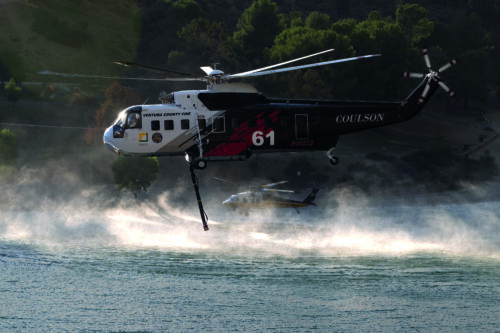
Under the Quick Reaction Force programme, Coulson delivers 24/7 operational capability
Kestrel’s techniques, procedures and risk mitigation were developed around the Bell 412, but with a focus on a broader application in terms of aircraft type, says Butterworth. “The governing rule set remains consistent across types, with only subtle changes to techniques required,” he says. The key operational and risk mitigation requirements are that the platform is an IFR-certified aircraft, has a two-pilot crew, NVIS-configured cockpit with a belly tank and snorkel. “The use of an IFR-capable aircraft and crew optimises the operational envelope when considering allowable weather minima and recovery planning from a potential loss of visual reference. There is also an increase in the use of white light for hover fill operations to enable obstacle identification and avoidance and suitable hover references,” he explains. Kestrel uses Point Trading’s Night Eyes Aviator binocular NVGs with Photonis Gen 4 Intens image intensifiers and a black and white image at the eyepiece lens, says Butterworth.
La Niña’s Impact on Aerial Firefighting in Australia
A third consecutive La Niña event during the 2022/23 Australian summer affecting the north and east of the country, resulting in higher-than-average rainfall, meant that the aerial firefighting fleet in those areas could see limited fire action compared with previous years. The fleet remains ready nonetheless.
Kestrel Aviation’s Specialised Fleet for Aerial Firefighting
Local aerial firefighting specialist Kestrel Aviation’s primarily Victoria-based fleet comprises Sikorsky UH-60A Black Hawks, an Airbus AS332L1 Super Puma, an Erickson Aircrane S-64F “Bubba”, Bell 412s and Bell 212s. The Black Hawk features the Helitak Belly Tank, while the Super Puma is equipped with a Simplex Belly Tank. Both are Type 1 medium to heavy helicopters, with the Super Puma having the added capability of CASR Part 110/133 passenger transport for up to 19 people.
 Supporting Flood Response in New South Wales and Victoria
Supporting Flood Response in New South Wales and Victoria
In late 2022, Kestrel’s aircraft saw considerable action in support of emergency agencies responding to floods in New South Wales and Victoria.
Adapting to the Limitations of the Season
In terms of the fire season, Kestrel Aviation’s Butterworth says: “This year is one of continued consolidation for the new, large Type 1 fleet of helicopters all contracted in Victoria, with the ongoing focus on innovation of the fire attack tanking systems to match Kestrel’s reputation of having the world-leading belly tank systems on their Type 2 helicopter fleet.”
He adds: “[Due to La Niña] this season may not provide the opportunity to showcase the full potential of the large helicopters. However, the investment by Victoria to have the best capability to protect communities is firmly in place.”
New South Wales Rural Fire Service’s (NSW RFS) Night Operations
New South Wales Rural Fire Service (NSW RFS) followed Victoria into night operations in the 2021-22 fire season with a trial using a Coulson CH-47 and NSW RFS’s two Bell 412s, which are operated by Coulson. The Bell 412, equipped with a FLIR camera, acts as a supervision and safety platform, identifying hazards, water sources and target areas for the drop, says the NSW RFS. “The aircraft conducted operations in and around the Richmond and Blue Mountains region within the Sydney Basin. The teams have yet to operationally fly a real fire in NSW due to the quiet season and lack of fire activity last year,” says Coulson.
NSW is building on its NAFF capability this season, with the ultimate objective to finalise and integrate a fully capable night-time firebombing capability.
The Catalyst: Black Summer Bushfires and Recommendations
NSW’s move followed the catastrophic Black Summer bushfires of 2019-20, which covered vast swathes of eastern Australia and were the worst bushfires NSW has experienced. In NSW alone, 26 lives were lost, 2,448 homes were destroyed and 5.5 million hectares of land were burnt. The NSW Bushfire Inquiry included a recommendation to trial NAFF with a view to full implementation if successful.
Interest and Progress in Other Australian States
Victoria’s and NSW’s night-time activities are being monitored across Australia. “Other States have expressed interest in setting up NVG programmes,” says Coulson. Interest is there, concurs Josephine Stirling, Deputy Director of the National Aerial Firefighting Centre (NAFC), which coordinates national aerial firefighting resources. The NAFC has provided support for Victoria’s and NSW’s night operations and disseminates information to other States. While Queensland and Western Australia, for example, haven’t progressed to trials, their interest is keen, and they are following what transpires in Victoria and NSW, says Stirling.
Kestrel’s Butterworth believes NAFF will continue to expand in Australia. “Interest in night fire suppression operations is broad-based, and most fire agencies have a watching brief over the activities in Victoria. However, the rate of uptake is slow, which appears to be driven by the successive La Niña events and other priorities,” he says, pointing to the costs associated and the demands it places on rostering highly skilled crews.
Despite this, however, he says: “We have no doubt that once night ops are engaged by each of the States, the capability will only expand as the benefits are realised.”
This article was originally published in the Feb/Mar ’23 edition of RotorHub International and won The Best Rotorcraft/Vertical Flight submission award at the 2023 Aerospace Media Awards and at the 2024 Aerospace Media Awards Asia


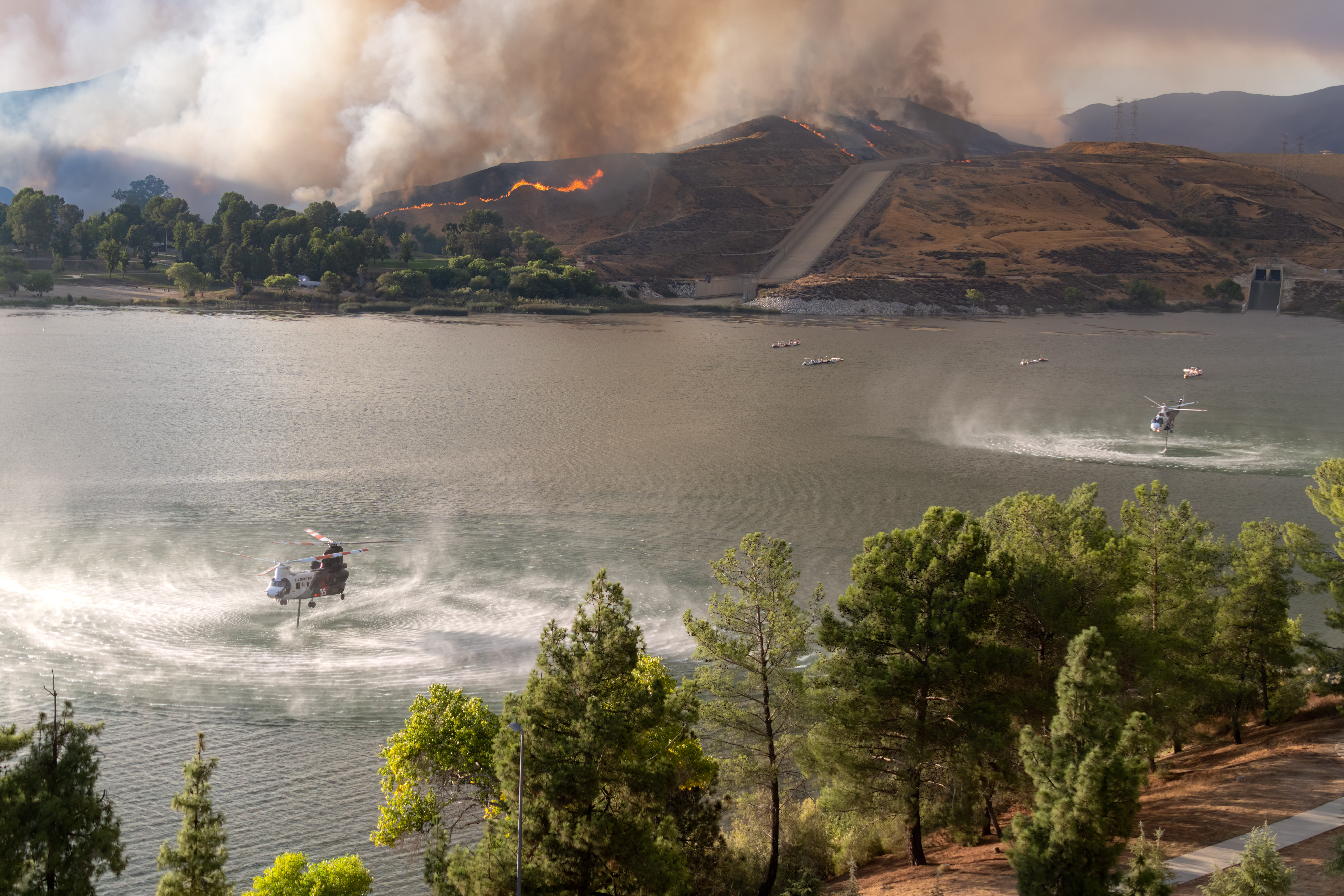
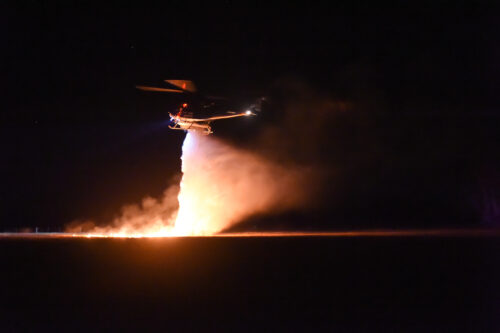 Supporting Flood Response in New South Wales and Victoria
Supporting Flood Response in New South Wales and Victoria

